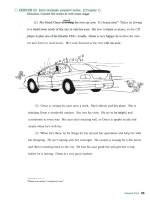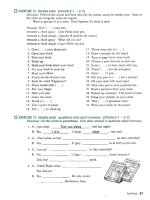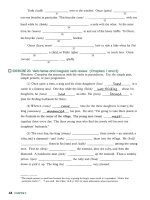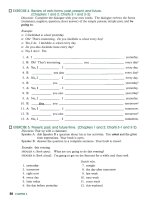Fundamentals of english grammar third edition part 2 docx
Bạn đang xem bản rút gọn của tài liệu. Xem và tải ngay bản đầy đủ của tài liệu tại đây (309.2 KB, 7 trang )
10-6
Passive modal auxiliaries
288
I>.
10-7
Using past participles as adjectives (stative passive)
292
.
10-8
Participial adjectives: -ed vs -ing
297
10-9
Get
+
adjective;get
+
past participle
300
10-10
Using be usedlaccustomedto and get usedlaccustomed to
303
10-11
Usedtovs .bousedto
305
10-12Usingbear~edto
307
Chapter
11
COUNTINONCOUNT NOUNS AND ARTICLES
11-1
Avs.an
312
.,
?
.
.
11-2
Countandnoncountnouns
313
11-3
Noncountnouns
314
11-4
Morenoncountnouns
315
11-5
Using several,
a
lot of, manylmuch, and afowla little
318
11-6
Nouns that can be count or noncount
322
.
.
11-7
Using units of measure with noncount nouns
324
-
.
;
11-8
Guidelines for article usage
326
11-9
Using the or
0
with names
338
11-10
Capitalization
339
Chapter
12
ADJECTIVE CLAUSES
12-1
Adjective clauses: introduction
343
12-2
Using who and whom in adjective clauses
344
12-3
Using who. who(m). and that in adjective clauses
347
12-4
Using which and that in adjective clauses
348
12-5
Singular and plural verbs in adjective clauses
354
12-6
Using prepositions in adjective clauses
355
12-7
Using whose in adjective clauses
359
Chapter
13
Chapter
14
GERUNDS AND INFINITIVES
13-1
Verb
+
gerund
368
13-2
Go+-ing
372
13-3
Verb+infinitive
373
13-4
Verb
+
gerund or infinitive
374
13-5
Preposition
+
gerund
381
13-6
Using by and with to express how something is done
384
13-7
Using gerunds as subjects; using it
+
infinitive
387
13-8
It
+
infinitive: usingjor (someone)
388
13-9
Expressing purpose with in order to and for
391
13-1 0
Using infinj.tLvej.*&
too
and
enough
A!,
394
NOUN CLAUSES
.
.
;
7
4.1
1::
j
3
14-1
Noun clauses: introduction
403
14-2
Noun clauses that begin with
a
question word
404
14-3
Noun clauses with who. what. whose
+
be
407
14-4
Noun clauses that begin with ifor whether
409
X
CONTENTS
14-5
Noun clauses that begin
with
that
414
14-6
Other
uses of that-clauses
415
14-7
Substituting
so
for a that-clause in conversational responses
418
14-8
Quoted speech
;
420
14-9
Quoted speech vs
.
reported speech
422
14-10
Verb forms in reported speech
423
141 1
Common reporting verbs:
tell,
ask.
answsrlrepZy
.
.425
APPENDIX
1
PHRASALVERBS
Al-1
Phrasal verbs: introduction
432
A1-2
Phrasal verbs: intransitive
443
A1-3
Three-word phrasal verbs
446
A1-4
Phrasal verbs: a reference list
449
APPENDIX
2
PREPOSITION COMBINATIONS
A2-1
Preposition combiiations: introduction
453
A2-2
Preposition combinations: a reference list
463
ANSWERKEY
465
INDEX
INDEX
1
Preface to the
Third Edition
Fundamentals of English Grammar
is a developmental skills text for lower-intermediate
and intermediate students of English as a second or foreign language. It combines clear
and understandable grammar information with a variety of exercises and activities.
FundammtaLF of English Gmmmar
is the second in a series of three texts:
Bmic
English
,
Gmmmar
(red cover),
Fundamentak ofEnglish Grammar
(black cover), and
Understanding
and Using English Grammar
(blue cover).
.I
The principal
aims
of all three texts in this series are to present clear, cogent
information about English grammar and usage, to provide extensive and varied practice
that encourages growth in all areas of language use, and to be interesting, useful, and
fun
for student and teacher alike. The approach is eclectic, with the texts seeking to balance
form-focused language-learning activities with abundant opportunities for engaged and
purposeful communicative interaction.
The new editions of the texts in the Azar Grammar Series include these changes:
The communicative aspects are more fully developed and explicit in the third
editions. This edition of
Fundamentals of English Grammar
includes a greatly
increased number of "real communication" opportunites for the teacher to exploit.
The text often uses the students' own life experiences as context and regularly
introduces topics of interest to stimulate the free expression of ideas in structured as
well as open discussions.
The
Azar
Grammar Series texts support the view of many experienced teachers
that grammar-based and communicative approaches are not murually exclusive, but
rather mutually supportive, and can advantageously co-exist in the same language
program, even in the same class, even in the same lesson.
Similarly, the interactive aspects of the texts receive greater emphasis in the third
editions. Many of the exercises formerly designated
ORAL
or
ORAL
(BOOKS
CLOSED)
are now reformatted to be more clearly available for pair work or group work, in
addition to still being viable as class work led by a teacher. This edition of
FundammtaLF of English Gmmmar
encourages interactivity but leaves it open for the
users to decide what degree of interactivity best suits their needs.
There is now an even wider variety of exercise types. This edition has a much larger
number of free-response exercises and open-ended communicative tasks, while still
providing ample controlled-response exercises to aid initial understanding of the
form, meaning, and usage of the target structures. It also includes more writing
topics, more speaking activities, new error-analysis exercises in every chapter, and
.
xiii
additional extended-context exercises. Classroom teaching materials formerly
found in the Wrkbook
are
now included in
this
student text, with the Wrkbook
devoted solely to self-study exercises. The Wrkbook has a variety of practice
,
approaches for independent study.
A specific change in this edition of Fundamentah of English Grammar is the two
Appendices, one
with
phrasal verbs and one
with
preposition combinations. Rather
than asking students
to
study a whole chapter of these phrases at one time, the
text
uses appendices to present them in smaller groupings for teachers to intersperse
throughout the teaching term. Another specific change is the omission of
conditional sentences, which
are
presented in Understanding and Using English
Grammar.
The accompanying Teacher's Guide is written for both experienced and
inexperienced teachers. It contains amplified
grammar
notes the teacher might
want to present to the class or
will
find useful as background information. It
outlines various ways of approaching the materials in the classroom and frequently
suggests fresh teaching ideas for individual exercises beyond the directions in the
text. It seeks to share
with
the teacher an understanding of the rationale behind the
text's content and approaches. Its principal purpose is to make the busy teacher's
job easier.
&I'
.i
,
,
. .
,
Fu?z&ment&
of
En&h
Grammar
consists of
.
,
1,'
a Snuient Book without an answer key
.
.
a
Snrdent Book with an answer key
-
.
a Wbook, consisting of self-study exercises for independent work
:
i,,
a Chanbook, a reference book consisting of only the grammar charts
,
,
.
a Teacher's Guide, with teaching suggestions and additional notes on grammar, as
well
as the answers
.
to $e exercises
.
,.
,,.
*
aTestBank,?,,:,:
c.,,
~,
,;
.I?,',
,
,
,.,.,:
.,
8
:-
XIV
PREFACE
Acknowledgments
The third edition of
FEG
was reviewed by nine ESIfEFL professionals. I wish to express
my thanks to these colleagues for their exceedingly helpful insights and suggestions. They
are Steohanie
La
Qua. International Center for American Endish: Diane Mahin,
-
-
~niveiity of ~ia& Amy Parker, Embassy CES Intensive English Program; ~a& Pietsch,
Green
River Community College; Thomas Pinkerton, North Miami Senior High School;
Haydie Alvarado Santos, University of Puerto Rico; Hye-Young
Urn,
Myongji University,
Seoul, Korea; Lyn Waldie, Helenic-American Union, Athens, Greece; Aida Zic,
Montgomery College.
My wholehearted thanks go to Shelley Hartle, who makes my job easy, and Editor Janet
Johnston, who guides and assists us in so very many ways. Editor Margo Grant is simply
super to work with, as are the many other skilled professionals at Pearson Education for their
contributions to the publication of this work; in particular, Joanne Dresner, Anne Boynton-
Tkigg,
Allen Ascher, Pam Fishman, Rhea Banker, Linda Moser, Aliza Greenblatt, Ray
Keating, Barry Katzen, Kate McLoughlin, Sylvia Herrera-Alaniz, Bruno Paul, Hugo Loyola,
Mike Bennett, Stacy Whittis, Monika Popowin, Julie Hamrnond, and Amy Durfy.
A special thank you is reserved for Production Editor Robert Ruvo, who stayed on top
of everythimg and remained unflappable.
I'd like to thank Carlisle Communications, Ltd., whose staff so excellently turned our
disks into print pages. Without a doubt, they are the most skilled and reliable compositors
I've worked with
in
twenty years.
I
also once again thank Don Martinetti, the illustrator, whose touches of whimsy are
so delightful. My appreciation also goes to graphic designer Christine Shrader, creator of
the swallow that heralds this third edition.
My great appreciation goes to Stacy Hagen, an experienced ESL author,* who created
new materials for the revised
Fundamentals
of
English Gmmmar
LWnkbook,
bringing fkesh
approaches and ideas. Working with her was a very good experience.
I wish to express special acknowledgment of the contributing writers for the previous
edition of the
Mrkbook:
Rachel Spack Koch, Susan Jamieson, Barbara Andrews, and Jeanie
Francis. Some of the exercise material originally created for that workbook has been woven
into this third edition of the student book, and
I
thank them for the ways in which this
material has enriched the text. I am additionally very grateful to Rachel Spack Koch for
her devotion and expertise in answering grammar and usage questions fkom teachers on
the current Azar Companion Web Site.
*SoMdAduica:A
Wasisfir
Lutning,
2000,
Pearson Educalion;
Wurer
Wr*ing
thmugh
Editing,
1999,
McGraw-Hill
[co-
author
Jan
Petanon);
and
SoundAduamw:A
Ronuncintia
Book,
1992, Pearson Education (co-author
Pat
Gmgan).
:
xv
I
am
indebted especially and always to my many students through the years;
I
learned
.
nuch from them.
I
also am indebted to my fellow ESYEFL materials writers, past and
sent; we learn much &om each orher.
I
would like to make special mention of Thomas
well and Irene Schoenberg.
In
addition, my thanks
go
to Donna Cowan, University of Washington, Patti
Gwe-
White, Sue Van Etten, Joy Edwards, my great pirls Chelsea and Rachel, and
my
@+'
':,
'!;
XVI
ACKNOWLEDGMENTS
CONTENTS
1-1 The simple present and the 1-4 Final
-s
present progressive 1-5 Spelling of final
-81-es
1-2 Forms of the simple present and 1-6 Non-action verbs
the present progressive 1-7 Present verbs: short answers to yeslno
1-3 Frequency adverbs questions
EXERCISE
1.
Introductions.
Directions:
You and your classmates are going to interview each other and then introduce
each other to the rest of the class.
I,,:
,I
ICuNIo:
MARIA:
mo:
MARIB:
-0:
MARIA:
ICUNIo:
MARIA:
.
.
KWO:
,.,!,'~2!,
MARIA:
ICuNIo:
!I,
qri
MARIA:
ICuNIo:
MARU:
mo:
MARIA:
KLINXo:
,
,',,,.',
Read and discuss the dialogue.
Hi.
My name is Kunio.
Hi.
My name is Maria. I'm glad to meet you.
,
.
,.::
.
I'm glad to meet you, too. Where are you from?
,
.
, ,
I'm from Mexico. Where are you from?
I'm from Japan.
Where are you living now?
.
,
.
.,
On
Fi
Avenue in an apartment. And you?
I'm living in a dorm.
How long have you been
in
(this
city)?
Three days.
Why did you come here?
',;
,,-,,'.
,
To study English at this school before
I
go to another school to study computer
programming. How about you?
I
came here two months ago. Right now I'm studying English. Later, I'm going
to study engineering at this school.
:,
3:
What do you do
in
your he time?
5
:
;:
.,
I
read a lot. How about you?
I
like
to get on the Internet.
Really?
What
do
you
do when you're online?
I
visit many different Web sites. It's
a
good
way
to practice my English.
That's interesting.
I
like to get on the Internet, too.









